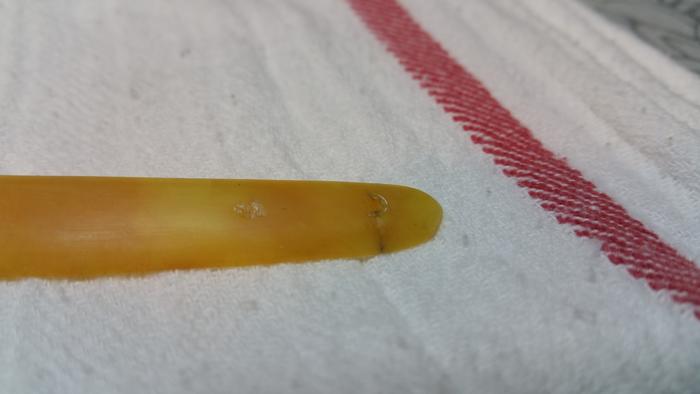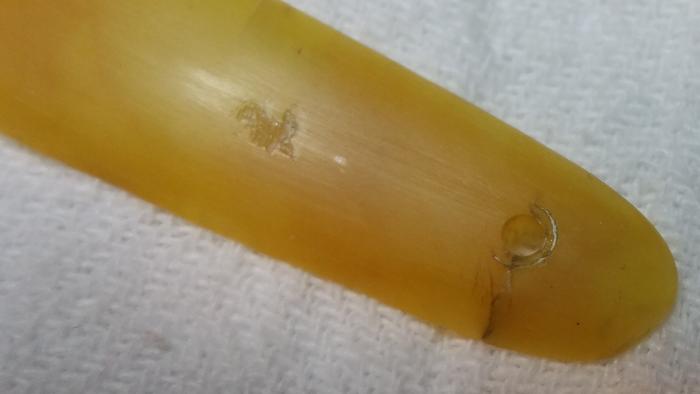Results 1 to 10 of 14
Thread: Fixable or no?
-
10-21-2017, 12:36 AM #1
 Fixable or no?
Fixable or no?
I took the scales off the next razor to restore and cleaned up the scales. I knew this crack was in the pivot end on one side and that the ware/grind mark was there too but I wasn't sure if/how to fix it if possible. I'm thinking its acrylic but not sure if CA would work. And if I was to use CA, how do I get the crack cleaner? Also, could that divot be filled with CA or what would you recommend for repair? Sand it down?

 It's just Sharpening, right?
It's just Sharpening, right?
Jerry...
-
10-21-2017, 03:05 AM #2Senior Member




- Join Date
- Feb 2013
- Location
- Haida Gwaii, British Columbia, Canada
- Posts
- 14,457
Thanked: 4830
Hmmmm. They look a lot like honey horn, however at this point I have to believe you would know if that were true. I have never successfully filled a crack in a pivot in any type of plastic scales and had them hold for ant length of time. That being said, you should try, that is how we discover new things and new techniques.
It's not what you know, it's who you take fishing!
-
10-21-2017, 04:52 AM #3

Subscribed. I will have to deal with a couple of divots as well.
-
10-21-2017, 04:59 AM #4

I dont think they are honey horn. They are more Yellow with light yellow swirls. I have a Boker with the same scales just a bit thinner. Ill try to cut out a small V on the inside and drop some CA in it. I'd really like to keep them but I'm afraid they will break when pinning.
I'll give it hell and see what happens I guess. Not to sure what to do with the divot. Fill? Sand? Guess one thing at a time. I could just leave the divot as its not going to hurt anything.
Thanks Rez.It's just Sharpening, right?
Jerry...
-
10-21-2017, 05:09 AM #5Senior Member




- Join Date
- Feb 2013
- Location
- Haida Gwaii, British Columbia, Canada
- Posts
- 14,457
Thanked: 4830
To be honest, there is one thing I have not tried. Eyelet style collars. You could fill the crack and the divot with CA and then polish them up and then pin them with the collars from Babar, his user name on the bay is razorhandles. He is from Germany and sells solid eyelet style collars. They are very handy and keep the pressure from pinning off the scales. Tom used them in a thread on pinning MOP scales. It is a good place to look at them as well as on the bay.
It's not what you know, it's who you take fishing!
-
10-21-2017, 05:51 AM #6Previously lost, now "Pasturized"


- Join Date
- Oct 2005
- Location
- Winnipeg Manitoba Canada
- Posts
- 1,333
Thanked: 351
If it's plastic, you can soak the end in rubbing alcohol in a plastic cup. Every now and then give it a light brushing with an old soft toothbrush to see if you can get the "gunk" out.
CA glue.... Cyanoacrylate is actually acrylic plastic when it cures, but it does not *melt* into the the previously hardened plastic. A thin rubbery epoxy would be my choice, but unless you have some already, it's probably not worth buying, just for that. I'd also try to use a vacuum chamber to get the epox to wick into the crack.
Using CA, the water thin type has the best chance of getting into the cracks if you get the gunk out.
For the divot, unless you can replicate the color AND grain.... I think it's going to look like a divot filled with "something". My personal view would be to try to just sand and buff it as smooth as you can, then leave it alone.
Regards
Christian"Aw nuts, now I can't remember what I forgot!" --- Kaptain "Champion of lost causes" Zero
-
The Following User Says Thank You to kaptain_zero For This Useful Post:
bluesman7 (10-21-2017)
-
10-21-2017, 01:56 PM #7

I agree on the divot. Thinking I'll sand it down and buff some and leave it be. I'll have to do both scales to try and keep thickness about the same. Soaking the end in rubbing alcohol and scrubbing a few times ... I'll give it a try. But I think I'm going to give it a hot pin test first. I dont think its horn but it would be best to know what it is before I go trying things.
Thanks gentlemen.It's just Sharpening, right?
Jerry...
-
10-22-2017, 09:32 PM #8

A while back I fixed a divot in a scales by cleaning with Alcohol, filling in the divot several times a little at a time with CA then sanding smooth and polishing. It takes a little time allowing the CA to dry between applications but well worth it IMHO.
"If You Knew Half of What I Forgot You Would Be An Idiot" - by DoughBoy68
-
The Following User Says Thank You to DoughBoy68 For This Useful Post:
Gasman (10-23-2017)
-
10-22-2017, 09:47 PM #9Senior Member



- Join Date
- Mar 2012
- Location
- Thunder Bay, Ontario, Canada
- Posts
- 17,350
Thanked: 3228
-
The Following User Says Thank You to BobH For This Useful Post:
Gasman (10-23-2017)
-
10-22-2017, 09:50 PM #10

Looks like celluloid. Iíve repaired several celluloid scales using acetone. If it were mine I would clean the crack and put a drop or two of acetone on the crack. You want to get it to wick into the crack. Acetone will melt the celluloid, so you donít want to over do it. You want just enough to melt the inside of the crack. If you do it correctly and it will melt together and dry as one solid piece again. It will be just as strong as it originally was. After the crack has been repaired you can sand and polish the scales.
B.J.
-


 15Likes
15Likes LinkBack URL
LinkBack URL About LinkBacks
About LinkBacks







 Reply With Quote
Reply With Quote
